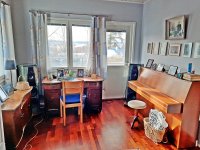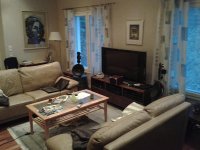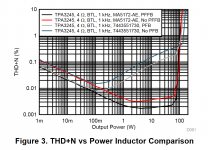Mixing analog and digital isn't as bad as it sounds. Sitting on my bed now listening to a pair of semi-diy 3-way speakers powered by two Hypex FA123. Source is Spotify on Yamaha WXC-50, sending analog unbalanced to each Hypex. Music starts playing when I select a piece wotih my laptop or phone and select device as "Bedroom" and Yammy and Hypexs start playing in a few seconds. No hum or noise, just plain hifi!
Other option is to select "Living room" in Spotify - and Yamaha RX-V685 wakes up and starts sending unbalanced RCA to Minidsp 4x10HD and ICEPower modules driving 4-way diy speakers. No need to stand up and walk to mechanical switches.
Makking all these fully digital is beyond my know-how. Totally wireess is even beyond my dreams and not personally needed in any way. (modern Scandinavian minimalistic interior could benefit from that perhaps?) Balcony use could be served with bluetooth speakers, but I don't want that at home - at work I have that (mono) for quiet background "noise".
Other option is to select "Living room" in Spotify - and Yamaha RX-V685 wakes up and starts sending unbalanced RCA to Minidsp 4x10HD and ICEPower modules driving 4-way diy speakers. No need to stand up and walk to mechanical switches.
Makking all these fully digital is beyond my know-how. Totally wireess is even beyond my dreams and not personally needed in any way. (modern Scandinavian minimalistic interior could benefit from that perhaps?) Balcony use could be served with bluetooth speakers, but I don't want that at home - at work I have that (mono) for quiet background "noise".
Attachments
The only thing i wish Hypex did differently, is their bi-quad implementation. It appears to bind tuning to their software, their procedure. Maybe not, but it's been something i've been unwilling to explore. That's a big negative imho.
Mark - you might be surprised at how easy it is. Yes, to create a DSP filter file you have to use the "Hypex Filter Design" software. However, on my most recent filter designs, I did all the design and development work in VituixCad2. Then I simply transposed (manually) each filter element from VituixCad into the Hypex tool. I got EXACTLY the expected response with one small exception**. For example, a typical filter element might be a 2nd order shelf, center frequency = 380 Hz, gain = + 6.5 dB, Q = 0.65. Manually copying this from VituixCad to Hypex HFD software would take about 30 seconds. The whole process for a 3 way filter was something like 15 minutes while sipping on coffee eating a cookie...
The HFD tool is a "visual" tool, you create the filters on what looks like a frequency response curve. However, it is easy to enter exact values for gain, f, Q.
** one small exception: The levels on the tweeter always need to be adjusted slightly different in HFD than what VituixCad predicts. The VituixCad simulation is within 2 dB of measured reality, but the final dial-in level is set by measurement. This may be (probably) is a measurement error on my part, but one I have not been able to ring out just yet... still, not a big deal.
j.
Last edited:
That's very good to hear Jim, nice to hear how easy and successful it's become for you.
And glad to learn how well it integrates with VituixCad.
I guess for me, being bound to the Hypex Filter Design software, is more about losing the freedom i have with processors that offer more options, particularly linear-phase xovers, and FIR in general. Sometimes I believe i've made speaker processing as much of a hobby as speaker building. lol
And glad to learn how well it integrates with VituixCad.
I guess for me, being bound to the Hypex Filter Design software, is more about losing the freedom i have with processors that offer more options, particularly linear-phase xovers, and FIR in general. Sometimes I believe i've made speaker processing as much of a hobby as speaker building. lol
Last edited:
The manufacturers for TPA3255 themselves seem to agree, nevertheless.
Yes, but passive multi-ways are rarely crossed over in the active way... 😕
I'm not arguing that post filter feedback isn't a good thing (if correctly implemented) only that its not essential for 'good' performance. If you look at the attached figure from slaa788a you can see that the choice of output inductor is far more important for THD than the feedback. The feedback is reducing THD but THD is already below audible without it for the MA5172-AE inductor.
*on your other point of passive crossovers in active speakers that's exactly what I do in my 3 way tops, the mid and tweeter have a passive crossover to improve SNR and protect the compression driver.
Attachments
Last edited:
Making all these fully digital is beyond my know-how. Totally wireless is even beyond my dreams and not personally needed in any way.
There's a method for LOS transmission of spdif signals. Metals like aluminium may also be used to reflect IR (like a mirror) without reflecting the visible wavelengths. Not everyone would prefer this, but it's just something "wireless" for the people who like many boxes but not as many cables.
Well, maybe, but there are other errors that pertain to the feedback path of the control loop that are neatly avoided by using a POL feedback, e.g. the non-linearity in the LC filter & the capacitor filtering the switching output before feedback (pre-filter case). The performance improvement also depends on loop gain and bandwidth.The feedback is reducing THD but THD is already below audible without it for the MA5172-AE inductor... that's exactly what I do in my 3 way tops
Regarding crossover, those inductors are air-core ones, aren't they? For air-core b=u0H, exactly. No distortion etc.
Last edited:
kipman725,
I'm only saying that an air-core inductor outside the loop of an amplifier is fine whereas an iron-powder/ferrite class-D inductor is not, due to its limited number of magnetic dipoles (that cause non-linear behaviour and eventual saturation). However, if inside the loop, the class-D inductor's non-linearity is neatly compensated by the loop-gain, giving a (mathematically) more accurate amplifier. The audibility of the resulting distortion is a rather subjective matter. It may indeed be inaudible to many, especially with an over-designed choke.
Further, the added impedance due to an air-core inductor in the crossover network (outside the loop) does not present an issue at all, as the voice-coil resistance/inductance (Re/Le) are already much bigger values when compared to it. However, that could be a problem in case of steel/ferrite inductors.
Regards.
Sorry, if we went off topic with that.
I'm only saying that an air-core inductor outside the loop of an amplifier is fine whereas an iron-powder/ferrite class-D inductor is not, due to its limited number of magnetic dipoles (that cause non-linear behaviour and eventual saturation). However, if inside the loop, the class-D inductor's non-linearity is neatly compensated by the loop-gain, giving a (mathematically) more accurate amplifier. The audibility of the resulting distortion is a rather subjective matter. It may indeed be inaudible to many, especially with an over-designed choke.
Further, the added impedance due to an air-core inductor in the crossover network (outside the loop) does not present an issue at all, as the voice-coil resistance/inductance (Re/Le) are already much bigger values when compared to it. However, that could be a problem in case of steel/ferrite inductors.
Regards.
Sorry, if we went off topic with that.
Last edited:
Was thinking this now and then too but to the defense of such threads where (mostly) boys dream about their toys with their feet in the wishing well,The FA-123 seems to check every box of the original wish list... except that it does not cost less than $75 and it is larger than a mobile phone.
I have to say that this sometimes helps get creative, think about solutions and eventually help others see them and last but not least to realize that all you need is already there.
As it seems zoudio is eventually having a TAS3251-version of the "digital XO+amps" in the works which would be a nice solution for lots of people.
Also another DIY-version of the TAS3251-chip:
[design log] Neat 2x170W I2S in, I2C controlled, integrated DSP amp (TAS3251)
The case for keeping the guts passive
I know this isn't what OP asked for, but I present the conservative's case, for doing it the old fashioned way.
I guess I'm old school. I much prefer the speaker boxes electrical components being all the typical passive elements, the active amplification being off-board and connected by as many wires as needed. This is, in fact my current system, three ways originally with internal passive XO (damaged) which was removed and system run active.
As you've already seen here, trying to put the active electronics in-board requires all manner of design choices and compromises. Maintenance and upgrading is a pain in the ***. And, the absolute best case in wire reduction will still be two connectors for external power (unless you plan to run on batteries?) + 1 connector, a TOSLINK at the least, or some other signal carrier (again, wireless is too much a compromise.) So no way will you be able to have less than three wires to each speaker.
With externally hosted active EQ, your worst case is 2x the number of drivers, so usually no more than three pair. Those pair can be relatively thin wiring too. Right now isn't the place to get into a wire debate. Let me just assert that you can use very thin, even solid core wire, and it works just fine for home use. At least, it does for me.
In sum, I can't think of any rational reason people would want the electronics in-board. Perhaps for mass-produced units. It really doesn't gain you anything, and the overall costs would seem to be quite a bit higher.
I know this isn't what OP asked for, but I present the conservative's case, for doing it the old fashioned way.
I guess I'm old school. I much prefer the speaker boxes electrical components being all the typical passive elements, the active amplification being off-board and connected by as many wires as needed. This is, in fact my current system, three ways originally with internal passive XO (damaged) which was removed and system run active.
As you've already seen here, trying to put the active electronics in-board requires all manner of design choices and compromises. Maintenance and upgrading is a pain in the ***. And, the absolute best case in wire reduction will still be two connectors for external power (unless you plan to run on batteries?) + 1 connector, a TOSLINK at the least, or some other signal carrier (again, wireless is too much a compromise.) So no way will you be able to have less than three wires to each speaker.
With externally hosted active EQ, your worst case is 2x the number of drivers, so usually no more than three pair. Those pair can be relatively thin wiring too. Right now isn't the place to get into a wire debate. Let me just assert that you can use very thin, even solid core wire, and it works just fine for home use. At least, it does for me.
In sum, I can't think of any rational reason people would want the electronics in-board. Perhaps for mass-produced units. It really doesn't gain you anything, and the overall costs would seem to be quite a bit higher.
Last edited:
Maintenance and upgrading is a pain in the ***
I’ve had passive crossover components fail which gave anomalies in the FR; i actually only discovered it by accident because I was measuring both L & R speakers; it took me hours to figure out it has a faulty cap in the HP circuit.
I’ve had tweeters fail (shorted voice coil)
I’ve had full HP portion of crossover fail (nothing coming out of filter; not yet fixed)
I’ve had a integrated amplifier fault; needing a full board ($$$) replacement due to use of SMD parts- too hard to isolate the problem)
My Hypex UcD400MP (OEM) failed and there no direct replacement.
In terms of serviceability nothing lasts forever. It’s nice to get a replacement 2 decades
Later like the SEAS T25CF002 but really nothing lasts forever…
So I don’t think it should be an exclusion for not using plate amp.
I’d like to pickup my speaker from the living room and pop it into
the bedroom and see how the acoustics affect the sound. A real pain with passive speakers but so easy with speakers with built in amps…
Last edited:
- Home
- Loudspeakers
- Multi-Way
- built-in electronics for active loudspeakers - a wish list


